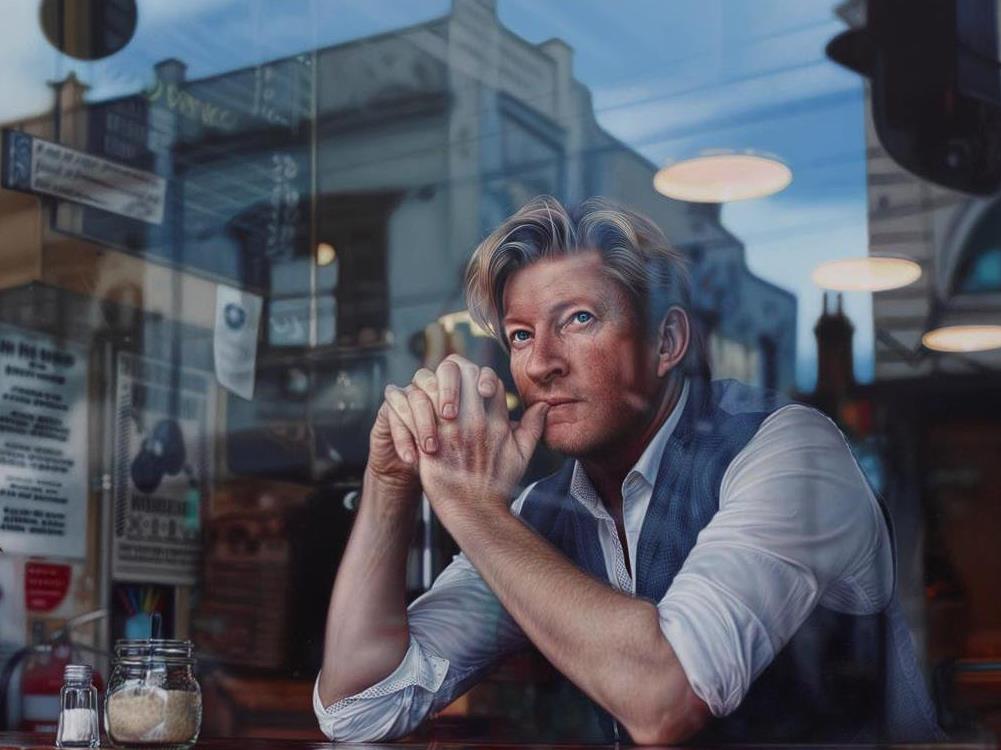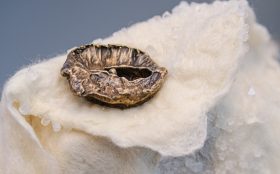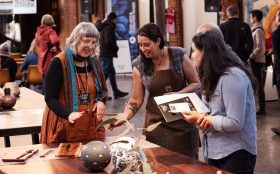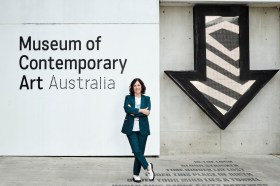Packing Room Prize 2019 winner Tessa Mackay’s Through the looking glass (detail), oil on linen, © the artist. Photo: AGNSW, Mim Stirling.
This year there are 107 finalists across the Archibald, Wynne and Sulman Prizes presented by the Art Gallery of NSW, drawn from a pool of 2,176 entrants. That means entrants have just a 5% chance of making the cut for Australia’s highest profile suite of art prizes.
Traditionally, the Archibald Prize (the Archi) has drawn not only huge crowds, but huge media interest, making it one of the most visible exhibitions annually. For an artist wanting to build their career, it’s a no-brainer that entering has its benefits.
ArtsHub spoke with a first time finalist, a regional finalist and a regular finalist to ascertain whether the exposure promised by the Archi is all hot air or whether it really does have value in building an artist’s career.
Why enter?
Paul Ryan described the Archibald as a carnival prize wheel ‘with a serious dose of nepotism and politics’. This year Ryan is a finalist in the Archi for the 13th time in his career. He has also been selected for the Sulman Prize – his seventh year in the running.
When asked why he persists, he told ArtsHub: ‘It’s a really fun thing to be involved with, and through those prizes over the years, I’ve become friends with so many artists. Then there is also some faint outside chance that you might win.’
He has no doubt that being a finalist helps. ‘Regardless of your views on the Archibald, it does get a lot of attention.’
This year Ryan has taken a spin on Velázquez’s painting Las meninas (1656), entering a portrait of artist James Drinkwater reflected in the mirror. Ryan describes it as a double portrait with himself and the Beastie Boys, a kind of studio ménage à trois.
‘It’s a painting about making a painting. Roughly 400 years ago Velázquez was doing a very post-modernist work. It is still a very powerful idea,’ explained Ryan.
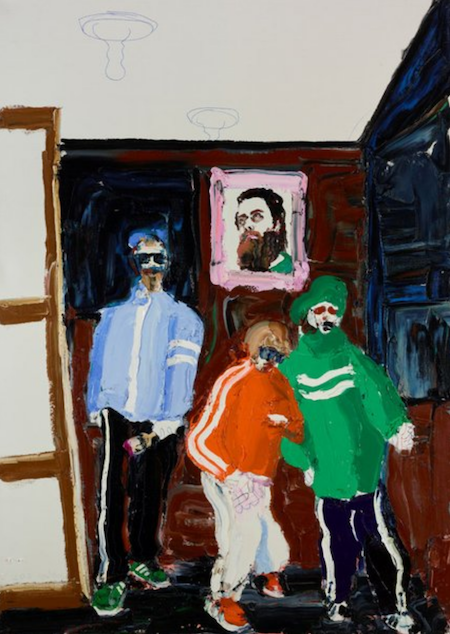
Paul Ryan, Self-portrait in the studio with the Beastie Boys, painting James Drinkwater for the Archibald Prize (Los amigos), courtesy the artist and Nanda Hobbs.
He described the prize as being ‘fairly Sydney-centric’, but said that it had broadened over the years, adding that ‘Melbourne galleries are even bragging about their artists getting in’.
First time finalist Tessa Mackay understands the benefit of reach. The Perth-based Mackay is among 38 entrants this year from Western Australia, and one of 12 of the 51 Archie finalists (21%) who are first time entrants.
This is her second attempt at the Prize, and it has paid off. She was named winner of the Packing Room Prize with a hyperreal portrait of the actor David Wenham, titled Through the looking glass.
Wenham has been a subject of the Archi twice before, in 2018 (Jordan Richardson) and in 2000 with a prize-winning portrait by Adam Cullen.
Mackay told ArtsHub she entered because she is not represented by a gallery. ‘It raises my profile significantly, and the trickle effect of that is going to be huge.’
Clare Thackway, who is based in regional NSW, is also a first time finalist. She said that it was not only the exposure of the Archi that encouraged her to enter but the genre itself that had a career connection for her. ‘As a figurative painter it is important to be in the mix with other painters working figuratively.’
Thackway added it also helped break down the isolation of her practice as a regional artist. ‘The fact that [the exhibition] travels to regional galleries is also a wonderful opportunity and exposure.’
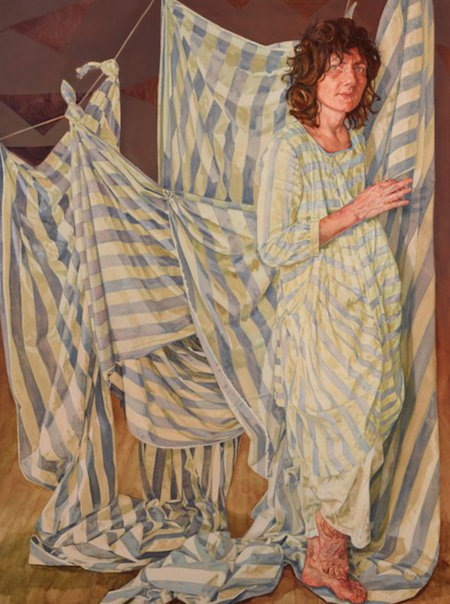
Clare Thackway’s finalist painting, Billow and tide, a portrait of artist Lauren Brincat; courtesy the artist.
How strategic are you about the prizes you enter?
Given that Mackay’s paintings takes months to create, she said, ‘I have to be thoughtful what I sink my time into and what my intentions are for the work.’ Her two Archibald entries consumed two years of her studio practice.
‘You have to be quite strategic and realistic about what is the best way to spend your time,’ she added.
Ryan enters a number of prizes each year. ‘I tend to enter prizes that fit the kind of work I do,’ he said. ‘It really is a marketing tool – it is about getting your work out there and getting your work seen.’
Thackway said that while she enters prizes regularly, she is strategic in her approach. ‘I try to enter things that I have made already, rather than making for prizes, otherwise they end up taking up your whole calendar and they are not necessarily the greatest reward, especially if they are interstate and you are couriering work.’
Both Mackay and Ryan believe that entering art prizes extends your practice.
Mackay said: ‘I just wanted a challenge to motivate myself, and the Archibald is a perfect catalyst to encourage an artist to find their subject, and to embolden them to reach out.’
Ryan noted: ‘It’s different to painting [for] an exhibition; you can do what you like, and you don’t have gallery owners looking over your shoulder saying “that might be a bit tough”.’
Ryan said his entries have changed dramatically over the years. ‘I started with no idea what portrait painting was, then I thought it was just “big heads”, and the last few years I’ve been trying to broaden my horizons of what a portrait can be. I haven’t been a finalist the last few years because I was working so left of centre – I pushed it too much.’
Ryan said that he only has one or two of his Archibald finalist paintings remaining in his private collection. ‘Who would have thought a prize was saleable?’ he laughed.
Advice on entering the Archi
Mackay said to ‘just do it for yourself’ while Ryan advised artists to ‘have some fun with it’ and Thackway urged entrants not to get ‘discouraged by the knock-backs’.
Mackay added: ‘You need to enter the Archie to benefit your own practice and allow it to encourage you to push yourself. The process of doing that helped me a lot.’
Thackway noted that ‘prizes aren’t the be-all-and-end-all. Just keep exhibiting!’ She added: ‘It’s important that the work you make makes sense in the context of your wider practice.’
The winners of the Archibald, Wynne and Sulman Prizes 2019 will be announced on Friday 10 May.
Archibald, Wynne, Sulman Prizes 2019
Art Gallery of New South Wales
11 May – 8 September 2019
Ticketed exhibition
Finalists can be viewed online:
Archibald Prize 2019 finalists
Wynne Prize 2019 finalists
Sulman Prize 2019 finalists
